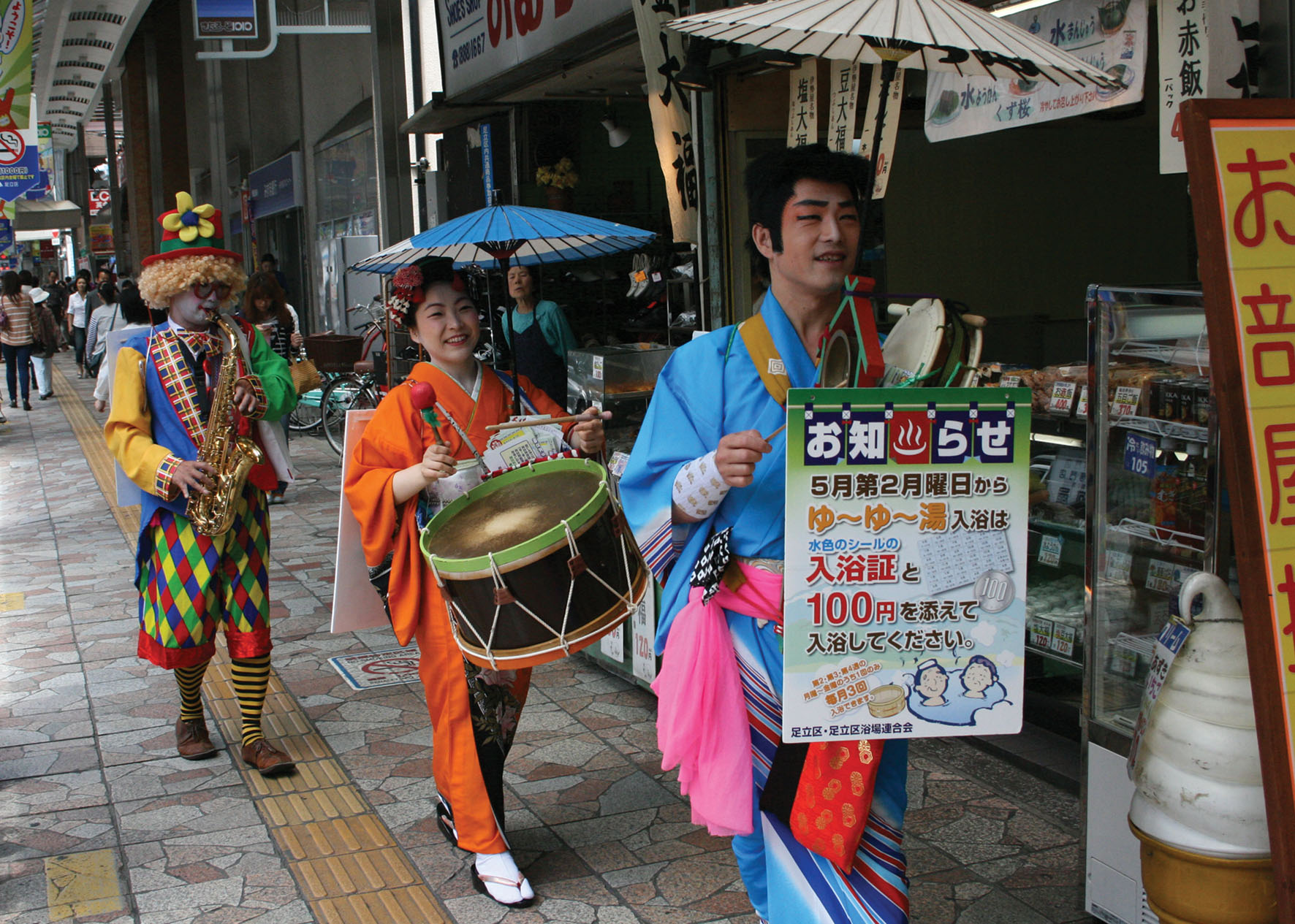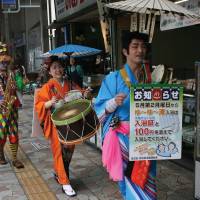Dear Alice,
Some years ago on a visit to Japan, in Osaka, we came across a wandering band dressed in full kimono and playing what sounded like Dixieland jazz on an odd assortment of Japanese and Western instruments. From what I could make out, they were promoting a business, but I never did learn what the heck that band was all about. Can you tell me?
Ross L., Adelaide, Australia
Dear Ross,
First of all, thank you for putting me onto a topic that was pure fun from start to finish. The group you saw was a chindonya, a form of street advertising that had its heyday after the war and is enjoying a modest comeback. Chindonya literally drum up business for their clients, attracting attention with outlandish costumes, nostalgic music and clever banter. I knew this much but went to the library to see what else I could find out.
I found a surprising number of books on the subject, some of which trace the history of chindonya to the middle of the 19th century, when a candy seller named Amekatsu supposedly started using noisemakers and songs to draw in business. I personally put more stock in an alternate theory that chindonya developed out of publicity bands that sprang up a little later and were called tōzaiya for their attention-getting cry of "Tōzai! Tōzai!" (Literally "East, west! East, west!" — the Japanese equivalent of "Hear ye, hear ye!") In any case, the word "chindonya" appeared in a newspaper headline in 1878, so they've been around at least that long.
By the way, the name comes from the sounds produced on a crazy three-in-one instrument that's pretty much unique to chindonya. Called a chindon taiko (drum), it's actually two drums and a gong, all fixed into a wooden frame that is strapped to the player's chest. The "chin" is the sound of the gong while "don" is the bang of the drum. The "ya" is a suffix that works like "-er."
A typical troupe has at least three members, led by a man in a flamboyant kimono and topknot wig. He's the oyakata (boss) and is usually the one carrying the chindon drum. It's also his job to call out announcements that are both witty and specific to the product or service they're promoting. Next in the procession may be a kimono-clad woman playing a shamisen or drum, and a third member on saxophone or clarinet who brings up the rear.
Chindonya flourished for a few decades after World War II, thanks mostly to pachinko parlors. These arcades offered pinball games and thinly disguised gambling, and were kept under strict regulation. Chindonya were one of the few ways they could legally advertise. Later, when restrictions were relaxed and television became widespread, demand for chindonya went down the tubes.
In recent years, however, there's been an influx of young, often college-educated entrepreneurs who have learned the trade from old-timers and set up their own businesses. There are currently about 25 full-time professional chindonya companies around the country, serving fairly specific niches in advertising including store openings. There are also amateur and student troupes. A good place to check out the state of the industry is the Chindonya Championship, held every April in Toyama City, Toyama Prefecture.
I followed one of these new-generation troupes as they wandered through the Kita-Senju neighborhood in Tokyo, out on a gig for the Adachi Public Bath Association. Their job was to publicize reduced-price baths for people over 70. I trailed along as they played old-fashioned songs such as "Take ni Susume" ("Sparrow in the Bamboo") and "Ringo no Uta" ("The Apple Song"). It threw me when they switched to "When the Saints Go Marching In," but it was clear that whatever they played their sound was a draw.
People came out of their homes and stores. Older people brought out their grandchildren, wanting the kids to get a look. "I haven't seen a chindonya in 30 years," one woman said, a big smile on her face. One man handed them a significant tip. "Treat yourselves to a drink later," he said. The band stopped often, handing out pamphlets with a personal word. And people took them. This was clearly more effective than just standing by a station and trying to get someone to take a flyer.
The boss that day was Hisashi Nagata, who is in his 40s and goes by the stage name Sankyu, a play on the way many Japanese pronounce "thank you." He invited me to come around and meet his wife Mika, who is also a professional chindonya; they met while apprenticed to separate oyakata and decided to set up together. They politely declined to discuss fees with me (unless I was hiring), but confirmed that they make their living as full-time chindonya. They're actually on the job about 15 days a month, with heavier bookings on weekends, but off-days are filled with business activities including maintaining their wigs, practicing sword play and waiting around in police stations.
It turns out one of the most onerous parts of being a professional chindonya is getting the necessary permits to advertise on the streets. "The older generation usually didn't bother with niceties like permits," Nagata told me. "If they saw a policeman they'd duck down an alley or set down their instruments and pretend to be out having a smoke." But the Nagatas do things by the book, which means having to apply in person at the police station for a dōrō shiyō kyoka (road-use permit). "Processing takes three business days, so we can't accept work on short notice. And you have to go back and pick it up. What's more, the fee, at ¥2,100, is really steep."
"What we need are lower fees and the ability to apply via the Internet," Nagata said. "Chindonya have changed with the times; the rules ought to change too."




